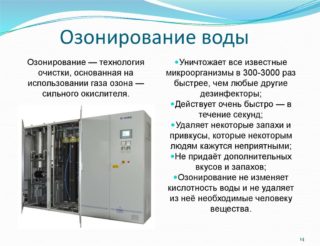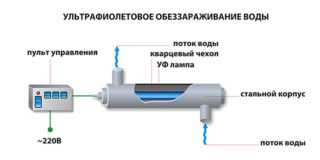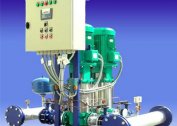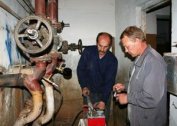The use of modern methods of disinfecting drinking water allows you to get rid of viruses and bacteria that pose a danger to humans. Destruction of pathogenic agents can occur partially or completely, depending on the initial quality of the fluid and the tasks set.
The need for disinfection
The rapid development of technology and industry has led to environmental pollution. Sources of fresh water (surface or underground) are infected with pathogens, chemical compounds or have an unpleasant residue. In their natural form, they are not suitable for drinking and can harm human health.
The use of water disinfectants allows you to get rid of harmful microorganisms. Most methods are used to treat domestic and industrial wastewater. There are modern methods of disinfection, allowing the use of prepared water for domestic needs from a centralized water supply.
Normative documents of the water sanitary legislation
The properties of drinking water are monitored and established by law. The main document that is used to assess its quality is called the Water Code. To control the characteristics of the liquid, other state standards are also applied:
- GOSTs. They contain standards by which quality control of wastewater and drinking water is carried out.
- SanPiNy. Contain hygienic requirements for water quality.
- SNiPs. Building standards that define the rules for the construction of treatment facilities, water supply systems.
In the process of monitoring water characteristics, the Federal Law “On the Sanitary and Epidemiological Well-Being of the Population” is necessarily used.
Effective disinfection methods
 There are a huge number of methods by which it will be possible to get rid of pathogenic agents in the composition of the liquid. They are conditionally divided into chemical, physical and combined.
There are a huge number of methods by which it will be possible to get rid of pathogenic agents in the composition of the liquid. They are conditionally divided into chemical, physical and combined.
Chlorination
It is considered the most reliable and easiest way to disinfect. Chlorination is very popular in Russia, which is also due to its following advantages:
- The means used for disinfection are relatively inexpensive.
- High efficiency of the method. After chlorination, the secondary growth of microorganisms does not occur, the appearance of algae is prevented.
- In addition to the pronounced bactericidal effect, after using the method, water is purified from iron, manganese, and sulfur-hydrogen.
Chlorination has several disadvantages. During oxidation, the agents used for purification acquire a high degree of mutagenicity and carcinogenicity. Using chlorine compounds, it is not possible to completely get rid of them, which sometimes makes the water unsuitable for drinking, leading to pollution of natural sources. Regularly using liquid purified in this way, a person exposes himself to the risk of developing oncology, gastrointestinal diseases, and the cardiovascular system.
Chlorine dioxide is increasingly being used for disinfection. The substance is more effective and safe. The only negative is that it must be used directly in production.
Ozonation
 The principle of the disinfection method is the effect of ozone gas on pathogenic microorganisms. It destroys viruses and bacteria, oxidizes some compounds that give water an unpleasant odor and taste.The advantages of ozonation are its quick disinfecting effect, a high degree of safety for humans and the environment.
The principle of the disinfection method is the effect of ozone gas on pathogenic microorganisms. It destroys viruses and bacteria, oxidizes some compounds that give water an unpleasant odor and taste.The advantages of ozonation are its quick disinfecting effect, a high degree of safety for humans and the environment.
The disadvantages of the method:
- the wrong dosage of ozone leads to an unpleasant odor in the treated liquid;
- ozone excess provokes metal corrosion in water pipes, household appliances;
- The gas used for cleaning belongs to the first hazard class.
Ozonation is an expensive disinfection method. High costs require maintenance of the applied installations.
Other chemical methods
When choosing a disinfection method, you should pay attention to such options:
- The use of heavy metal ions, bromine, iodine.
- Disinfection with strong oxidizing agents - sodium hypochlorite.
- Disinfection using noble metal ions - silver.
Biopag is the most popular drug used to kill pathogens in a liquid environment. Most often used for swimming pools, water parks, aquariums. This method of cleaning is chosen because of its safety, ease of use. After its use, water does not acquire an unpleasant odor or taste. The disadvantage of this method is that after cleaning, the liquid can cause irritation to the skin or mucous membranes.
Ultraviolet
 Before exposure to UV rays, the liquid is pre-filtered and coagulated. This helps to get rid of large particles and helminth eggs. Subsequently, they switch to physical disinfection using ultraviolet radiation. It is important to correctly calculate the amount of energy that needs to be applied to treat a certain amount of water. The duration of exposure to UV radiation also depends on the number of pathogenic microorganisms in each milligram of liquid.
Before exposure to UV rays, the liquid is pre-filtered and coagulated. This helps to get rid of large particles and helminth eggs. Subsequently, they switch to physical disinfection using ultraviolet radiation. It is important to correctly calculate the amount of energy that needs to be applied to treat a certain amount of water. The duration of exposure to UV radiation also depends on the number of pathogenic microorganisms in each milligram of liquid.
The water disinfection unit consists of special lamps placed in quartz cases. The efficiency of the equipment depends on the quality of the liquid. The more transparent it is, the further the radiation propagates. Such installations require regular maintenance (once every three months).
The advantage of the method is the possibility of its individual use. UV-producing lamps have a long life (thousands of hours). Also, this disinfection method is ideal for camping conditions. To perform the cleaning by the natural method, it is enough to put a container with liquid under direct sunlight for 6 hours.
Ultrasound
The method is based on the effect of cavitation. Certain sound frequencies are capable of creating voids that form a large pressure difference. This leads to the rupture of the cell walls of pathogenic viruses, bacteria and to their death.
The value of the ultrasonic cleaning method for industry is negligible. The method is expensive and difficult to use.
Electropulse disinfection method
Water purification is carried out by electrolysis. The liquid is affected by an electric discharge, which forms a shock wave. Pathogenic microorganisms falling under its influence die.
The advantage of the method is its effectiveness when exposed to troubled water. Before disinfection, the liquid does not require preliminary cleaning. After electrolysis, even very tenacious bacteria die, and the positive effect of the procedure lasts up to 4 months. The disadvantage of the method is its high cost.
Heat exposure
 Boiling is an improvised time-controlled method of disinfection. Thermal exposure can improve the properties of the fluid from a well, well, water supply. Using boiling, it is possible to get rid of almost all harmful microorganisms. After heat exposure, water hardness is significantly reduced while maintaining its taste.
Boiling is an improvised time-controlled method of disinfection. Thermal exposure can improve the properties of the fluid from a well, well, water supply. Using boiling, it is possible to get rid of almost all harmful microorganisms. After heat exposure, water hardness is significantly reduced while maintaining its taste.
Handy disinfection methods
To purify water from pathogenic microorganisms in the field, you can use ordinary hydrogen peroxide. It is added in the amount of 1 tablespoon per 1 liter. Then the liquid is defended for an hour. To speed up the breakdown of peroxide, 1-2 tablets of activated carbon are added to the water.
Method selection
Before using a specific disinfection method, the initial water quality is taken into account. The characteristics of the liquid to be obtained as a result of cleaning are taken into account. These requirements are set forth in the regulatory documents for water used for drinking or household needs, for swimming pools.
When choosing methods, allowable capital and operating costs are also taken into account. Many methods of disinfection (using ultraviolet, ultrasound) require the use of expensive equipment, specially trained personnel.



